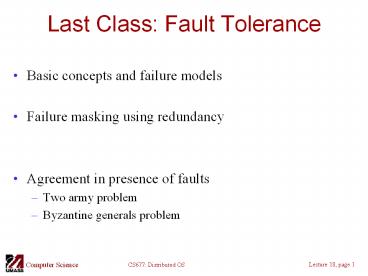Last Class: Fault Tolerance - PowerPoint PPT Presentation
Title:
Last Class: Fault Tolerance
Description:
Basic concepts and failure models. Failure masking using redundancy ... Sender can become bottleneck. NACK-based schemes. CS677: Distributed OS. Computer Science ... – PowerPoint PPT presentation
Number of Views:20
Avg rating:3.0/5.0
Title: Last Class: Fault Tolerance
1
Last Class Fault Tolerance
- Basic concepts and failure models
- Failure masking using redundancy
- Agreement in presence of faults
- Two army problem
- Byzantine generals problem
2
Today More on Fault Tolerance
- Reliable communication
- One-one communication
- One-many communication
- Distributed commit
- Two phase commit
- Three phase commit
- Failure recovery
- Checkpointing
- Message logging
3
Reliable One-One Communication
- Issues were discussed in Lecture 3
- Use reliable transport protocols (TCP) or handle
at the application layer - RPC semantics in the presence of failures
- Possibilities
- Client unable to locate server
- Lost request messages
- Server crashes after receiving request
- Lost reply messages
- Client crashes after sending request
4
Reliable One-Many Communication
- Reliable multicast
- Lost messages gt need to retransmit
- Possibilities
- ACK-based schemes
- Sender can become bottleneck
- NACK-based schemes
5
Atomic Multicast
- Atomic multicast a guarantee that all process
received the message or none at all - Replicated database example
- Problem how to handle process crashes?
- Solution group view
- Each message is uniquely associated with a group
of processes - View of the process group when message was sent
- All processes in the group should have the same
view (and agree on it)
Virtually Synchronous Multicast
6
Implementing Virtual Synchrony in Isis
- Process 4 notices that process 7 has crashed,
sends a view change - Process 6 sends out all its unstable messages,
followed by a flush message - Process 6 installs the new view when it has
received a flush message from everyone else
7
Distributed Commit
- Atomic multicast example of a more general
problem - All processes in a group perform an operation or
not at all - Examples
- Reliable multicast Operation delivery of a
message - Distributed transaction Operation commit
transaction - Problem of distributed commit
- All or nothing operations in a group of processes
- Possible approaches
- Two phase commit (2PC) Gray 1978
- Three phase commit
8
Two Phase Commit
- Coordinator process coordinates the operation
- Involves two phases
- Voting phase processes vote on whether to commit
- Decision phase actually commit or abort
9
Implementing Two-Phase Commit
actions by coordinator while START _2PC to local
logmulticast VOTE_REQUEST to all
participantswhile not all votes have been
collected wait for any incoming vote
if timeout while GLOBAL_ABORT to local
log multicast GLOBAL_ABORT to all
participants exit record
voteif all participants sent VOTE_COMMIT and
coordinator votes COMMIT write GLOBAL_COMMIT
to local log multicast GLOBAL_COMMIT to all
participants else write GLOBAL_ABORT to
local log multicast GLOBAL_ABORT to all
participants
- Outline of the steps taken by the coordinator in
a two phase commit protocol
10
Implementing 2PC
actions by participant write INIT to local
logwait for VOTE_REQUEST from coordinatorif
timeout write VOTE_ABORT to local log
exitif participant votes COMMIT write
VOTE_COMMIT to local log send VOTE_COMMIT to
coordinator wait for DECISION from
coordinator if timeout multicast
DECISION_REQUEST to other participants
wait until DECISION is received / remain
blocked / write DECISION to local log
if DECISION GLOBAL_COMMIT
write GLOBAL_COMMIT to local log else if
DECISION GLOBAL_ABORT write
GLOBAL_ABORT to local log else write
VOTE_ABORT to local log send VOTE ABORT to
coordinator
actions for handling decision requests
/executed by separate thread / while true
wait until any incoming DECISION_REQUEST is
received / remain blocked / read most
recently recorded STATE from the local log
if STATE GLOBAL_COMMIT send
GLOBAL_COMMIT to requesting
participant else if STATE INIT or STATE
GLOBAL_ABORT send GLOBAL_ABORT to
requesting participant else skip
/ participant remains blocked /
11
Three-Phase Commit
- Two phase commit problem if coordinator crashes
(processes block) - Three phase commit variant of 2PC that avoids
blocking
12
Recovery
- Techniques thus far allow failure handling
- Recovery operations that must be performed after
a failure to recover to a correct state - Techniques
- Checkpointing
- Periodically checkpoint state
- Upon a crash roll back to a previous checkpoint
with a consistent state
13
Independent Checkpointing
- Each processes periodically checkpoints
independently of other processes - Upon a failure, work backwards to locate a
consistent cut - Problem if most recent checkpoints form
inconsistenct cut, will need to keep rolling back
until a consistent cut is found - Cascading rollbacks can lead to a domino effect.
14
Coordinated Checkpointing
- Take a distributed snapshot discussed in Lec 11
- Upon a failure, roll back to the latest snapshot
- All process restart from the latest snapshot
15
Message Logging
- Checkpointing is expensive
- All processes restart from previous consistent
cut - Taking a snapshot is expensive
- Infrequent snapshots gt all computations after
previous snapshot will need to be redone
wasteful - Combine checkpointing (expensive) with message
logging (cheap) - Take infrequent checkpoints
- Log all messages between checkpoints to local
stable storage - To recover simply replay messages from previous
checkpoint - Avoids recomputations from previous checkpoint































